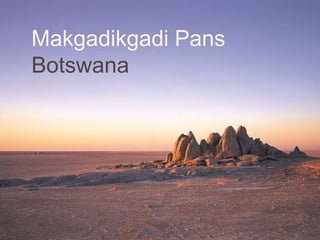Salt Lakes
- 3. Hundreds of new fish species are thought to have originated in this massive lake
- 4. Eventually all the water dried up, Over thousands of years the climate become hotter and drier and the lake lost its water source
- 5. As the water evaporated Lake Makgadikgadi gradually begun to dry up, leaving only a thick layer of salt, sand and animal remains
- 6. All that is left today is a series of huge salt flats covering 12,000 km2
- 7. Although the main lake has dried up there is still enough water during the rainy season to provide an important breeding ground for flamingos
- 8. The Makgadikgadi Salt Pans are so huge they can be seen from space! Can you see them?
- 9. Can you name any other features or countries? Makgadikgadi Salt Pans
- 10. Can you name any other features or countries? Kalahari Desert Makgadikgadi Salt Pans Okavango Delta Lake Kariba Lake Malawi Cape Fold Mountains
- 11. Letâs find out what the Makgadikgadi is likeâĶ (Otherwise you wonât be able to do your exam and you will DIE!)
- 12. Top Gear Botswana Special Make sure you note down any key facts or characteristics that are mentioned as you will be tested after!
- 13. MA K ADI K ADI Just add a G (for top Gear) after each K G G
- 14. Can you help me remember any key information from the video?
- 15. What are the characteristics of a salt lake? A salt lake is a lake that has a very high salt content It can vary greatly in size. Some are very large and permanently have water, e.g. the Dead Sea between Jordan and Palestine/Israel, which is fed by the River Jordan. Others are much smaller or shallower and only exist when it rains (ephemeral salt lakes). In the dry season there is just a salt pan. A salt pan is a large, flat, featureless plain with a hard crust of salt on the surface giving it a white appearance. Underneath this hard crust is a thick layer or mud and sediment.
- 16. How do salt lakes form? A salt lake may form when rainwater collects in a deflation hollow Or it could be the end point of river in an endoreic drainage basin (where the water drains into a lake instead of the sea) such as the Dead Sea. Makgadikgadi also used to be a permanent lake fed by a river. If the rate of evaporation exceeds the rate at which water is added the lake will gradually dry up and become a salt pan/salt flat.
- 17. How do salt lakes form? As the water evaporates it leaves behinds salt minerals. These are precipitated from the salts that were dissolved in the water. At the same time the evaporation encourages capillary action â the upward movement of water in the soil. This brings even more salt to the surface where it accumulates as a hard crust of salt. This is usually white in colour and may crack into polygonal shapes. More and more salt accumulates as ephemeral salt lakes form and dry up over and over.
- 18. Salt flats provide breeding grounds, natural resources of salt minerals as well as flat land for speed records! They can take thousands of years to form, which is why environmentalists accused Jeremy Clarkson of permanently scarring the Makgadikgadi salt pans and encouraging environmentally insensitive behaviour. Oops!
- 19. Salt Mining in Salar de Uyuni, Bolivia
- 20. The Dead Sea
- 21. Hiro Koiso
- 22. Creative photography in the Uyuni Salt Flats showing the polygonal cracks on the surface
- 23. Can you answer this question? Describe the characteristics and explain the formation of salt lakes (7 marks)
- 24. 1. Start by describing what theyâre like e.g. size, shape, colour, location, if/when they contain water Describe the characteristics and explain the formation of salt lakes (7 marks) 2. Then explain how they are formed Try to give a sequence of steps and give a sense of time using words like âgraduallyâ Try to use key words and give some specific examples Crust Ephemeral Capillary action Evaporation Deflation hollow Endoreic Salt pan Polygonal Precipitated Perennial
























